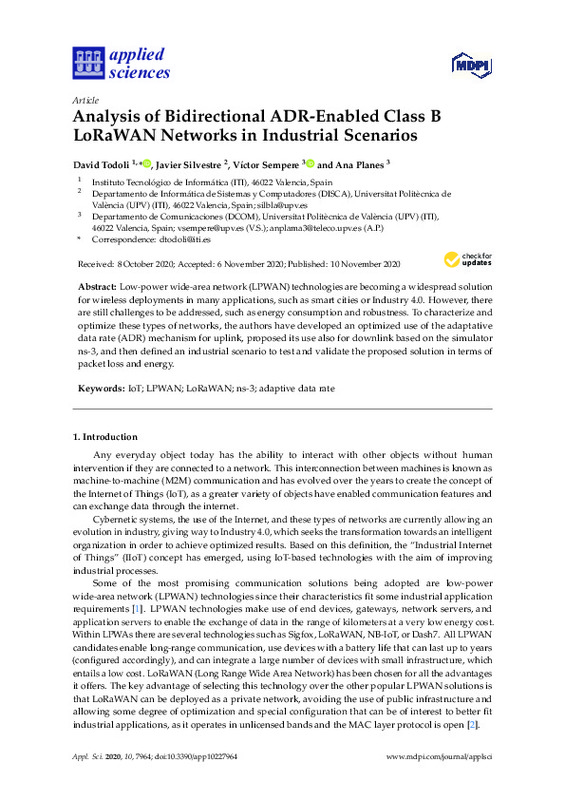JavaScript is disabled for your browser. Some features of this site may not work without it.
Buscar en RiuNet
Listar
Mi cuenta
Estadísticas
Ayuda RiuNet
Admin. UPV
Analysis of Bidirectional ADR-Enabled Class B LoRaWAN Networks in Industrial Scenarios
Mostrar el registro sencillo del ítem
Ficheros en el ítem
| dc.contributor.author | TODOLI FERRANDIS, DAVID
|
es_ES |
| dc.contributor.author | Silvestre-Blanes, Javier
|
es_ES |
| dc.contributor.author | Sempere Paya, Víctor Miguel
|
es_ES |
| dc.contributor.author | Planes, Ana
|
es_ES |
| dc.date.accessioned | 2021-05-01T03:31:05Z | |
| dc.date.available | 2021-05-01T03:31:05Z | |
| dc.date.issued | 2020-11 | es_ES |
| dc.identifier.uri | http://hdl.handle.net/10251/165835 | |
| dc.description.abstract | [EN] Low-power wide-area network (LPWAN) technologies are becoming a widespread solution for wireless deployments in many applications, such as smart cities or Industry 4.0. However, there are still challenges to be addressed, such as energy consumption and robustness. To characterize and optimize these types of networks, the authors have developed an optimized use of the adaptative data rate (ADR) mechanism for uplink, proposed its use also for downlink based on the simulator ns-3, and then defined an industrial scenario to test and validate the proposed solution in terms of packet loss and energy. | es_ES |
| dc.description.sponsorship | The research leading to these results received funding from the Horizon 2020 Programme of the European Commission under Grant Agreement No. 825631 "Zero Defect Manufacturing Platform (ZDMP)". It was also partially supported by the MCyU (Spanish Ministry of Science and Universities) under the project ATLAS (PGC2018-094151-B-I00). | es_ES |
| dc.language | Inglés | es_ES |
| dc.publisher | MDPI AG | es_ES |
| dc.relation.ispartof | Applied Sciences | es_ES |
| dc.rights | Reconocimiento (by) | es_ES |
| dc.subject | IoT | es_ES |
| dc.subject | LPWAN | es_ES |
| dc.subject | LoRaWAN | es_ES |
| dc.subject | Ns-3 | es_ES |
| dc.subject | Adaptive data rate | es_ES |
| dc.subject.classification | INGENIERIA TELEMATICA | es_ES |
| dc.subject.classification | ARQUITECTURA Y TECNOLOGIA DE COMPUTADORES | es_ES |
| dc.title | Analysis of Bidirectional ADR-Enabled Class B LoRaWAN Networks in Industrial Scenarios | es_ES |
| dc.type | Artículo | es_ES |
| dc.identifier.doi | 10.3390/app10227964 | es_ES |
| dc.relation.projectID | info:eu-repo/grantAgreement/EC/H2020/825631/EU/Zero Defect Manufacturing Platform/ | es_ES |
| dc.relation.projectID | info:eu-repo/grantAgreement/AEI/Plan Estatal de Investigación Científica y Técnica y de Innovación 2017-2020/PGC2018-094151-B-I00/ES/SLICING DINAMICO EN REDES DE ACCESO RADIO 5G/ | es_ES |
| dc.rights.accessRights | Abierto | es_ES |
| dc.contributor.affiliation | Universitat Politècnica de València. Departamento de Comunicaciones - Departament de Comunicacions | es_ES |
| dc.contributor.affiliation | Universitat Politècnica de València. Departamento de Informática de Sistemas y Computadores - Departament d'Informàtica de Sistemes i Computadors | es_ES |
| dc.description.bibliographicCitation | Todoli Ferrandis, D.; Silvestre-Blanes, J.; Sempere Paya, VM.; Planes, A. (2020). Analysis of Bidirectional ADR-Enabled Class B LoRaWAN Networks in Industrial Scenarios. Applied Sciences. 10(22):1-17. https://doi.org/10.3390/app10227964 | es_ES |
| dc.description.accrualMethod | S | es_ES |
| dc.relation.publisherversion | https://doi.org/10.3390/app10227964 | es_ES |
| dc.description.upvformatpinicio | 1 | es_ES |
| dc.description.upvformatpfin | 17 | es_ES |
| dc.type.version | info:eu-repo/semantics/publishedVersion | es_ES |
| dc.description.volume | 10 | es_ES |
| dc.description.issue | 22 | es_ES |
| dc.identifier.eissn | 2076-3417 | es_ES |
| dc.relation.pasarela | S\421947 | es_ES |
| dc.contributor.funder | European Commission | es_ES |
| dc.contributor.funder | Agencia Estatal de Investigación | es_ES |
| dc.description.references | Ayoub, W., Samhat, A. E., Nouvel, F., Mroue, M., & Prevotet, J.-C. (2019). Internet of Mobile Things: Overview of LoRaWAN, DASH7, and NB-IoT in LPWANs Standards and Supported Mobility. IEEE Communications Surveys & Tutorials, 21(2), 1561-1581. doi:10.1109/comst.2018.2877382 | es_ES |
| dc.description.references | Zero Defect Manufacturing Platformhttps://www.zdmp.eu/ | es_ES |
| dc.description.references | Finnegan, J., Brown, S., & Farrell, R. (2018). Evaluating the Scalability of LoRaWAN Gateways for Class B Communication in ns-3. 2018 IEEE Conference on Standards for Communications and Networking (CSCN). doi:10.1109/cscn.2018.8581759 | es_ES |
| dc.description.references | Luvisotto, M., Tramarin, F., Vangelista, L., & Vitturi, S. (2018). On the Use of LoRaWAN for Indoor Industrial IoT Applications. Wireless Communications and Mobile Computing, 2018, 1-11. doi:10.1155/2018/3982646 | es_ES |
| dc.description.references | Kim, S., & Yoo, Y. (2018). Contention-Aware Adaptive Data Rate for Throughput Optimization in LoRaWAN. Sensors, 18(6), 1716. doi:10.3390/s18061716 | es_ES |
| dc.description.references | Ta, D.-T., Khawam, K., Lahoud, S., Adjih, C., & Martin, S. (2019). LoRa-MAB: A Flexible Simulator for Decentralized Learning Resource Allocation in IoT Networks. 2019 12th IFIP Wireless and Mobile Networking Conference (WMNC). doi:10.23919/wmnc.2019.8881393 | es_ES |
| dc.description.references | Abdelfadeel, K. Q., Cionca, V., & Pesch, D. (2018). Fair Adaptive Data Rate Allocation and Power Control in LoRaWAN. 2018 IEEE 19th International Symposium on «A World of Wireless, Mobile and Multimedia Networks» (WoWMoM). doi:10.1109/wowmom.2018.8449737 | es_ES |
| dc.description.references | ns-3 Model Library, Online Resourcehttps://www.nsnam.org/doxygen/classns-3_1_1_hybrid_buildings_propagation_loss_model.html#details | es_ES |
| dc.description.references | Code Repositoryhttps://github.com/dtodoli/ns3_lorawan_work | es_ES |








